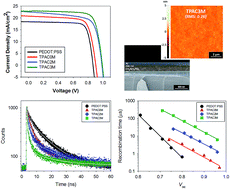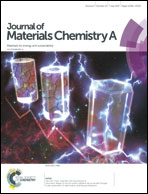Inverted planar perovskite solar cells with dopant free hole transporting material: Lewis base-assisted passivation and reduced charge recombination†
Abstract
Three novel triarylamine derivatives (TPACs: TPAC0M, TPAC2M and TPAC3M), sharing the same conjugation scaffold but possessing different numbers of methoxy units, were designed for high performance hole transport materials (HTMs) of p–i–n planar perovskite solar cells (PSCs). Cyclic voltammetry and absorption results showed that their energy levels would be beneficial to work as HTMs of PSCs, and time-resolved photoluminescence and transient photo-voltage studies proved that TPAC-based PSCs had better charge extraction and more suppressed non-radiative recombination properties than PEDOT:PSS-based PSCs, leading to superior power conversion efficiency (PCE). We confirmed that the methoxy units introduced to the triarylamine derivatives did not cause noticeable changes in their optical properties, such as absorption and bandgap, electrical conductance, measured by conductive atomic force microscopy, and mobility, but the charge extraction and recombination behaviors of TPAC-based PSCs could be improved by increasing the number of methoxy units in the arylamine moiety. X-ray photoelectron spectroscopy revealed that methoxy units could act as a Lewis base passivating the defect sites at the interface between HTM and perovskite, consequently resulting in an increase of their PCE to 17.54% without any dopants.



 Please wait while we load your content...
Please wait while we load your content...